Nepal, a tapestry of lofty peaks and lush valleys, is more than just a trekker’s paradise. This country serves as a sanctuary for a myriad of plant and animal species, many of which are endangered or unique to the region. At Luxury Holidays Nepal, we are privileged to offer tours that highlight the nation's conservation efforts, immersing our guests in the heart of Nepal's breathtaking natural reserves. Dive into a world where conservation areas, wildlife reservations, and even hunting zones coexist, painting a holistic picture of Nepal's approach to environmental stewardship.
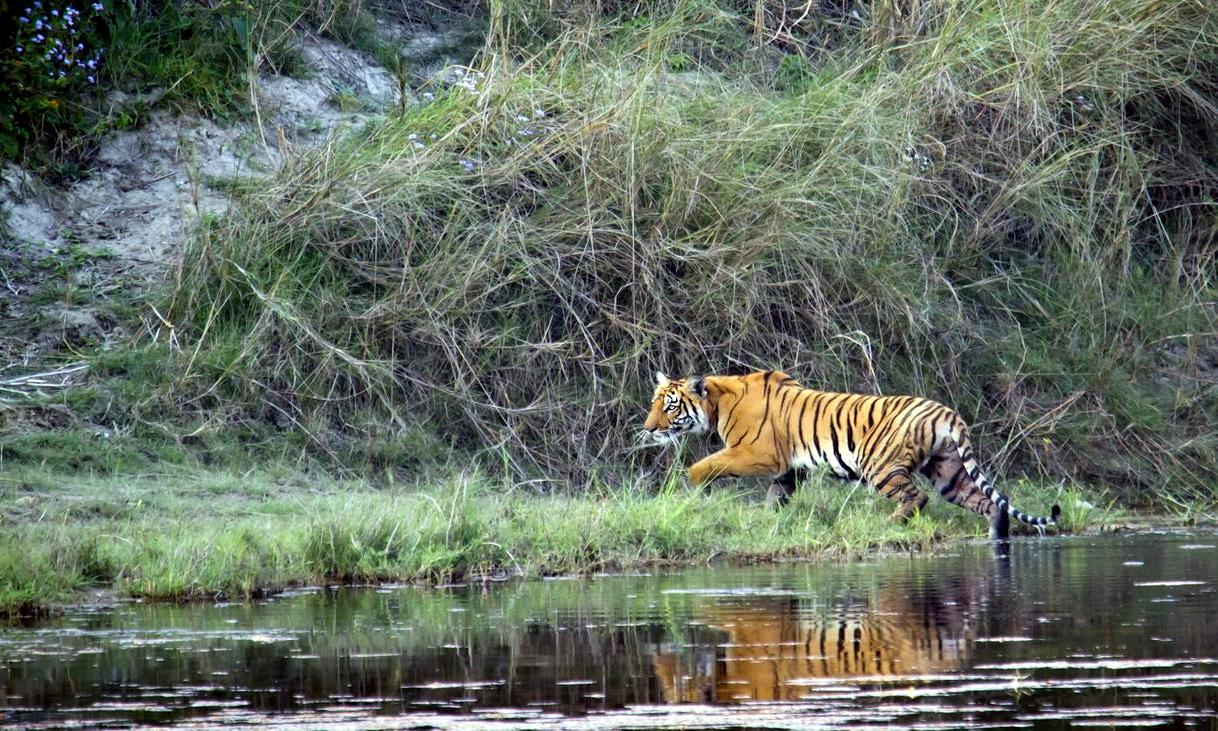
Conservation Areas are a testimony to Nepal's dedication to preserving both its diverse ecosystems and the intricate tapestry of human cultures that thrive within them. Unlike traditional protected regions, these areas uniquely blend ecological safeguarding with sustainable development, ensuring that local communities benefit directly from conservation initiatives. Places like the Annapurna Conservation Area and the Manaslu Conservation Area provide a profound insight into this balance, revealing pristine landscapes intertwined with rich cultural tapestries.
Wildlife Reservations are where nature unfurls in its purest form. Crafted to shield, nurture, and celebrate wildlife, these reservations are essential safe havens for many of Nepal's iconic species. Chitwan National Park and Bardia National Park, two of the country's most famed reservations, are teeming with biodiversity. From the stealthy Bengal tiger to the majestic one-horned rhinoceros, these reserves encapsulate the wild essence of Nepal.
Nepal's Hunting Zones offer a nuanced approach to conservation. While hunting, by nature, seems at odds with conservation, Nepal’s regulated hunting zones like the Dhorpatan Hunting Reserve are an innovative strategy to maintain ecological balance. Through controlled and licensed hunting, these zones aim to manage species populations, safeguarding the broader ecological dynamics of the region.
Conservation Areas
Conservation Areas in Nepal represent a pioneering approach that integrates nature conservation with sustainable socio-economic development. Unlike national parks and wildlife reserves, where priorities are strictly conservation-oriented, these areas focus on achieving a balance between environmental protection and the well-being of the local communities.
Annapurna Conservation Areas
Spanning a staggering 7,629 sq. km., the Annapurna Conservation Area (ACA) is not only Nepal's largest conservation area but also a haven of diverse landscapes. From the lush subtropical woodlands to the barren high-altitude deserts of the Trans-Himalayan region, ACA promises a myriad of experiences.
Unique Attractions Within ACA
- Annapurna Base Camp: A jewel for trekkers, the base camp offers unfiltered views of the majestic Annapurna Massif.
- Ghorepani Poon Hill: Renowned for its breathtaking sunrise, Poon Hill offers panoramic views of the entire Annapurna and Dhaulagiri mountain ranges.
- Tilicho Lake: Lying at an altitude of 4,919 meters, it's often revered as the highest lake of its size in the world.
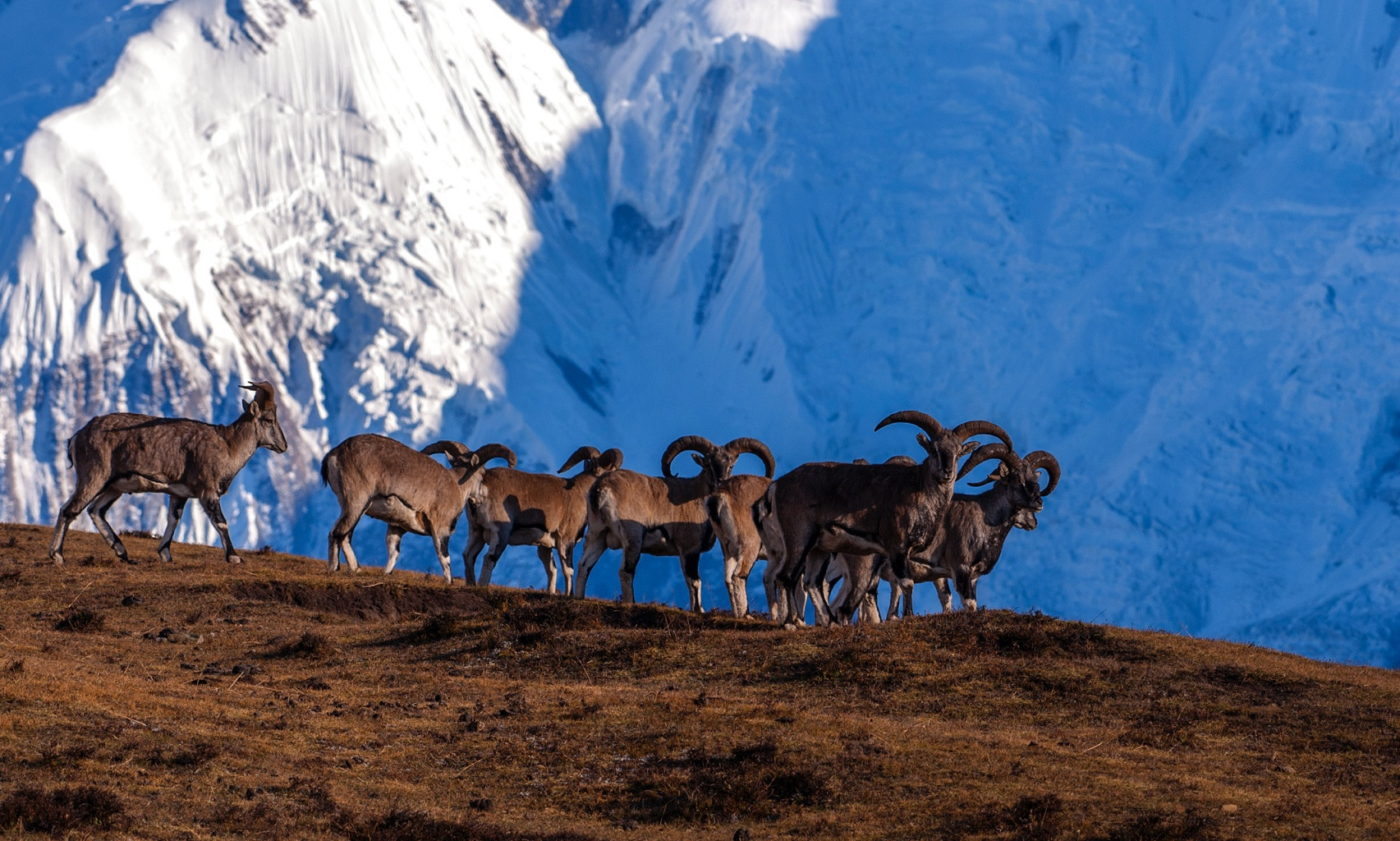
Species Include
- Snow Leopard: A ghostly presence in the higher altitudes, the snow leopard is a symbol of the wild Himalayas.
- Himalayan Tahr: A robust herbivore, the Tahr is frequently spotted grazing on rugged mountainous terrains.
Cultural Highlights
- Gurung Villages: Renowned for their ancestral ties to the region and unique customs.
- Tibetan Plateau Settlements: Offering a glimpse into the life and practices of Tibetan Buddhism.
Best Time: September to November (autumn) and March to May (spring). Clear skies offer majestic views of the Annapurna range, while these months provide pleasant trekking conditions.
The Annapurna Conservation Area (ACA), with its myriad landscapes, vibrant cultures, and diverse wildlife, is a testament to Nepal's commitment to sustainable tourism and conservation. With Luxury Holidays Nepal, your journey into this mesmerizing region promises luxury, authenticity, and memories that last a lifetime.
Kanchenjunga Conservation Area
Spread over 2,035 sq. km., the Kanchenjunga Conservation Area (KCA) envelops visitors in a tapestry of alpine grasslands, dense temperate and sub-tropical forests, and low river valleys. Named after Mount Kanchenjunga, the world's third-highest peak, this conservation area is more than just snow-clad summits—it's a realm of biodiversity and cultural treasures.
Key Attractions Within KCA
- Yalung Glacier: A dramatic expanse of ice and snow, providing trekkers with unparalleled vistas.
- Olangchung Gola: An ancient village known for its rich history and as a gateway for traders traveling to and from Tibet.
- Lhonak Valley: A serene, high-altitude plain that offers breathtaking panoramas of surrounding peaks.
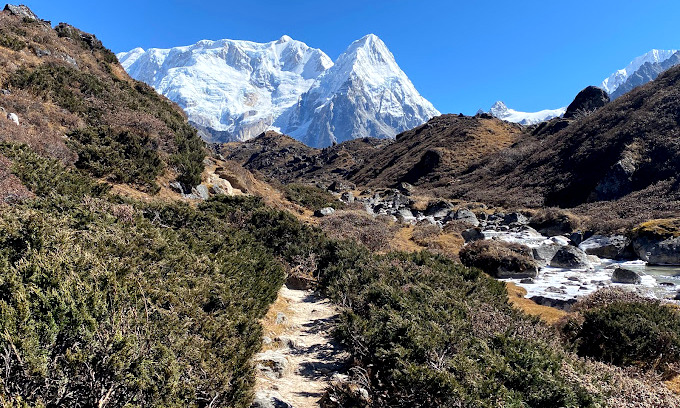
Species Include
- Red Panda: With their rust-colored fur and playful antics, these creatures are a delight for wildlife enthusiasts.
- Himalayan Black Bear: A symbol of the wilderness that dominates the lower altitudes of the region.
Cultural Experiences
- Limbu Cultural Trails: Dive deep into the practices and traditions of the Limbu community.
- Monasteries and Gompas: Witness the spiritual practices that have shaped life in these mountains for centuries.
Best Time: October to mid-December (autumn) is ideal for clear views and moderate temperatures. Spring (March to May) also presents vibrant rhododendron blooms.
The Kanchenjunga Conservation Area (KCA) stands as a testament to nature's raw beauty and the harmonious coexistence of diverse cultures. As you embark on this journey with Luxury Holidays Nepal, you're not just exploring a region—you're immersing yourself in a world where luxury and authenticity blend to craft an unforgettable experience.
Manaslu Conservation Areas
Encompassing an area of 1,663 sq. km., the Manaslu Conservation Area (MCA) showcases a delicate balance of natural splendor and rich cultural heritage. Shadowed by the towering peak of Mount Manaslu, this conservation area is a haven for trekkers, nature lovers, and cultural enthusiasts alike.
Prominent Attractions Within MCA
- Larkya La Pass: Perched at an altitude of 5,106 meters, this pass offers trekkers breathtaking views of the Manaslu and Annapurna ranges.
- Tsum Valley: A secluded valley renowned for its unique culture, sacred Buddhist sites, and heartwarming hospitality.
- Samagaon Village: A gateway for trekkers heading towards Manaslu Base Camp, offering a glimpse into local Gurung lifestyles.

Signature Species Include
- Snow Leopard: The mystical feline of the high Himalayas, treading stealthily across alpine terrains.
- Himalayan Blue Sheep: Often spotted by trekkers, these herbivores are a staple prey for snow leopards.
Cultural Highpoints
- Buddhist Monasteries: Delve into the serenity of monasteries like Rachen Gompa and Mu Gompa in Tsum Valley.
- Nubri and Tsum Cultures: Engage with local communities to understand their customs, festivals, and daily lives.
The Manaslu Conservation Area (MCA) is not just a destination; it's an experience. With its majestic landscapes, diverse ecosystems, and rich cultural offerings, MCA epitomizes what Nepal has to offer. And with Luxury Holidays Nepal at your side, expect every moment here to be crafted with precision, luxury, and authenticity.
Best Time: This region is best explored during the post-monsoon months of September to November when the landscapes are lush and the skies clear.
Gaurishankar Conservation Area
Covering an expanse of 2,179 sq. km., the Gaurishankar Conservation Area (GCA) is dominated by the twin peaks of Mount Gaurishankar, revered by both Buddhists and Hindus. Beyond its towering peaks, GCA offers lush forests, shimmering rivers, and ancient settlements.
Key Highlights Within GCA
- Tsho Rolpa Lake: One of the largest glacial lakes in Nepal, its turquoise waters are a treat for the eyes.
- Bigu Gompa: A picturesque nunnery located amidst serene landscapes, reflecting the region's deep-rooted Buddhist influence.
- Sailung Hill: Offering panoramic views of the Himalayan range, it's the epitome of tranquility.
Species Include
- Red Panda: This charismatic mammal, with its striking red coat, can occasionally be spotted in the region's dense bamboo forests.
- Musk Deer: Known for its prized musk, this elusive creature roams the higher altitudes of the conservation area.
Cultural Explorations
- Sherpa Villages: Delve into the heart of Sherpa culture, understanding their traditions, dances, and way of life.
- Ancient Monasteries and Chortens: Witness the region's spiritual vibe, exploring places of worship and meditation.
Best Time: This region is best explored during the post-monsoon months of September to November when the landscapes are lush and the skies clear.
The Gaurishankar Conservation Area (GCA) is not merely a destination—it's a realm where nature, culture, and spirituality converge. Every step taken here resonates with history, every view is a painting, and every moment, when crafted with Luxury Holidays Nepal, becomes a treasured memory.
Api Nampa Conservation Area
Spanning over an impressive 1,903 sq. km., the Api Nampa Conservation Area (ANCA) is named after its two prominent peaks: Mount Api and Mount Nampa. But beyond these snow-clad giants, the conservation area promises dense forests, roaring rivers, and quaint villages that time seems to have forgotten.
Must-Visit Spots Within ANCA
- Khalanga Bazaar: The district headquarters of Darchula, offering a unique blend of modernity and tradition.
- Mahakali River: A significant river that not only nourishes the region but also serves as a natural border between Nepal and India.
- Api Himal Base Camp: The starting point for trekkers and mountaineers aiming to conquer Mount Api.

Key Species to Spot
- Himalayan Musk Deer: Often seen in the alpine meadows, these creatures are known for their distinctive aroma-producing glands.
- Snow Leopard: The apex predator of the high Himalayas, their sightings, though rare, are an unforgettable experience.
Cultural Insights
- Byans Valley: Home to the Rung community, this valley offers an insight into their customs, rituals, and lifestyle.
- Traditional Fairs: The region is known for its vibrant fairs and festivals, especially those related to agricultural cycles and religious celebrations.
The Api Nampa Conservation Area (ANCA) is a testament to Nepal's commitment to preserving both its natural wonders and its cultural heritage. As you step into this wonderland with Luxury Holidays Nepal, be prepared for a symphony of experiences that are both authentic and luxurious.
Blackbuck Conservation Area
Encompassing a relatively small yet vital area of about 16.95 sq. km., the Blackbuck Conservation Area (BCA) in Bardiya District is Nepal's commitment to preserving the endangered Blackbuck antelope. Its open grasslands and meadows make for an ideal habitat for these antelopes and other resident wildlife.
Prime Attractions Within BCA
- Blackbuck Herds: Witness the majestic blackbucks galloping in the open fields, especially during early mornings and late afternoons.
- Traditional Tharu Villages: Get a glimpse of local life and culture in the adjacent villages.
- Bird Watching: The area is home to various bird species, making it a haven for bird enthusiasts.
Distinctive Species Include
- Indian Peafowl: With their vibrant plumage, they add a splash of color to the landscape.
- Jackals and Hares: Often spotted roaming the grasslands, they play crucial roles in the area's ecology.
Cultural Experiences
- Tharu Dance Performances: An expressive art form that tells tales of history, nature, and daily life.
- Local Gastronomy: Savor traditional dishes that are unique to the Terai region, offering flavors that are both rich and diverse.
The Blackbuck Conservation Area (BCA) stands as a testament to conservation efforts that not only protect a singular species but also enrich the larger ecosystem. With Luxury Holidays Nepal guiding the way, travelers can expect a journey that balances luxury, authenticity, and a deep respect for nature.
Wildlife Reserve
Nepal, often celebrated for its snow-clad Himalayas, offers another contrasting beauty at its southern edge: the lush green plains known as Terai. Here, the country's wildlife reserves provide sanctuary for an astounding array of creatures. With Luxury Holidays Nepal, step into the wild heart of Nepal, where luxury meets unspoiled nature.
Shuklaphanta Wildlife Reserve
Spanning an area of 305 sq. km., Shuklaphanta Wildlife Reserve is characterized by its vast grasslands, dense sal forests, and myriad water bodies. Originally established to protect the endangered swamp deer, the reserve has since expanded its conservation efforts to embrace a vast array of species.

Major Highlights Within Shuklaphanta
- Rani Tal: A picturesque oxbow lake, it is an oasis for birdlife and a tranquil spot for visitors.
- Grasslands: These vast meadows are the prime habitat for the swamp deer and a favored hunting ground for the Royal Bengal tiger.
- Watch Towers: Offering panoramic views of the reserve, these towers are the best spots for wildlife sightings.
Prominent Species Include
- Royal Bengal Tiger: A symbol of wilderness, spotting this magnificent beast is a moment to cherish.
- Swamp Deer: With their majestic antlers, these deer are the flagship species of the reserve.
- One-horned Rhinoceros: Having been reintroduced here, these armored giants add to the reserve's allure.
Cultural Insights
- Tharu Village Tours: Engage with the indigenous Tharu community, understanding their harmonious coexistence with nature.
- Traditional Performances: The local dances, rich in storytelling, offer glimpses into the folklore of the region.
Best Time: The drier months from October to March are suitable for wildlife sightings, especially in the grasslands. The temperatures are also relatively cooler in the Terai plains during these months.
Shuklaphanta Wildlife Reserve is not just a sanctuary for animals; it's a haven for souls seeking solace in nature's embrace. With Luxury Holidays Nepal guiding your path, every journey into this reserve promises luxury, adventure, and memories that echo with the wild calls of Shuklaphanta.
Koshi Tappu Wildlife Reserve
Covering an area of 175 sq. km., the Koshi Tappu Wildlife Reserve stands as one of the most significant wetland ecosystems in Nepal. Established in 1976, the reserve is renowned for its remarkable birdlife, making it a must-visit for avid birdwatchers.
Distinctive Features of Koshi Tappu
- Ramsar Site: Recognized as a wetland of international importance, it's a testament to the area's ecological significance.
- Barrage and Wetlands: The Koshi Barrage and its adjoining wetlands are teeming with aquatic life and migratory birds.
- Sunset Views: The reserve offers breathtaking sunset views over the Koshi River, painting the sky in hues of gold.

Birding Highlights Include
- Waterfowl and Waders: From storks to ibises, and from ducks to waders, the reserve is an avian theater.
- Migratory Birds: During winters, birds from as far as Siberia find solace in the wetlands of Koshi Tappu.
- Endemics and Rarities: Species like the red-necked falcon and Bengal florican add to the reserve's ornithological allure.
Cultural Experiences Include
- Local Homestays: Experience the warmth of eastern Nepali hospitality, savoring home-cooked meals and traditional stories.
- Craft Workshops: Engage in local craftsmanship, learning about the art of weaving, pottery, and other indigenous crafts.
Best Time: For bird enthusiasts, the migratory season from November to February is unmatched. Resident bird species and wildlife are active year-round, but cooler months are more comfortable for visitors.
The Koshi Tappu Wildlife Reserve is where the rhythm of nature comes alive, reverberating with the calls of birds and the whispers of the river. Join Luxury Holidays Nepal for an expedition that promises the beauty of nature with the comfort of luxury, ensuring memories that resonate with the soulful tunes of Koshi Tappu.
Parsa Wildlife Reserve
Encompassing an area of over 627 sq. km., the Parsa Wildlife Reserve boasts a diverse habitat range, from sal forests to grasslands and riverine ecosystems. Established in 1984, it has grown in ecological importance and conservation impact over the decades.
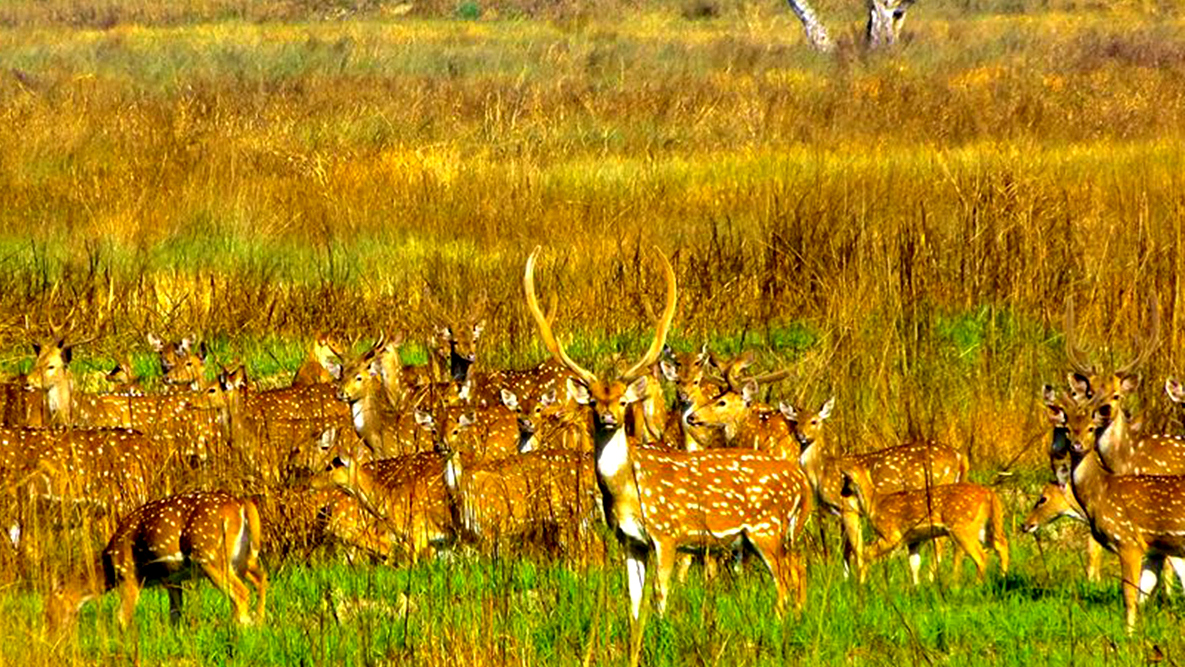
Highlights of Parsa
- Extended Biodiversity: While it complements the biodiversity of Chitwan, Parsa has its unique set of flora and fauna to showcase.
- Tiger Tracking: As a part of Nepal's tiger range, Parsa offers adventurous tiger tracking experiences for wildlife enthusiasts.
- Jeep Safaris: Traverse the vast landscapes of the reserve, enhancing chances of spotting varied wildlife.
Iconic Inhabitants Include
- Royal Bengal Tiger: Parsa plays a crucial role in Nepal's tiger conservation efforts, making it a haven for these majestic felines.
- Wild Elephants: Roaming in their natural habitat, they symbolize the wild spirit of the Terai plains.
- Gaur (Indian Bison): These gigantic herbivores are a sight to behold, showcasing the reserve's rich mammalian diversity.
Local Encounters Include
- Tharu Village Tours: Delve into the lives of the Tharu community, appreciating their customs, dances, and age-old traditions.
- Local Gastronomy: Relish the flavors of Terai as you sample local delicacies, each telling a story of its own.
Best Time: The drier months from October to March are suitable for wildlife sightings, especially in the grasslands. The temperatures are also relatively cooler in the Terai plains during these months.
The Parsa Wildlife Reserve stands as a testament to Nepal's commitment to conservation, offering a serene escape from the beaten path. With Luxury Holidays Nepal at your side, every moment in Parsa is a luxurious embrace of nature, culture, and unparalleled adventure.
Hunting Reserve
Nepal, renowned for its conservation efforts across national parks and wildlife reserves, also introduces another facet of wildlife management: hunting reserves. Through controlled and sustainable hunting practices, these reserves aim to balance human needs with wildlife conservation. Dive deep into this less-explored aspect with Luxury Holidays Nepal, where comfort encounters the untamed wilderness.
Dhorpatan Hunting Reserve
Spread over 1,325 sq. km., Dhorpatan Hunting Reserve is the sole hunting reserve in Nepal. Established in 1987, it represents a blend of conservation goals and local community benefits.
Unique Aspects of Dhorpatan
- Controlled Hunting Blocks: The reserve is divided into specific blocks where licensed hunting of certain species is permitted.
- Diverse Ecosystems: From alpine to sub-alpine and temperate zones, the reserve boasts a varied habitat.
- Rare Flora and Fauna: Apart from the huntable species, Dhorpatan is home to various endangered species, making it an ecological hotspot.
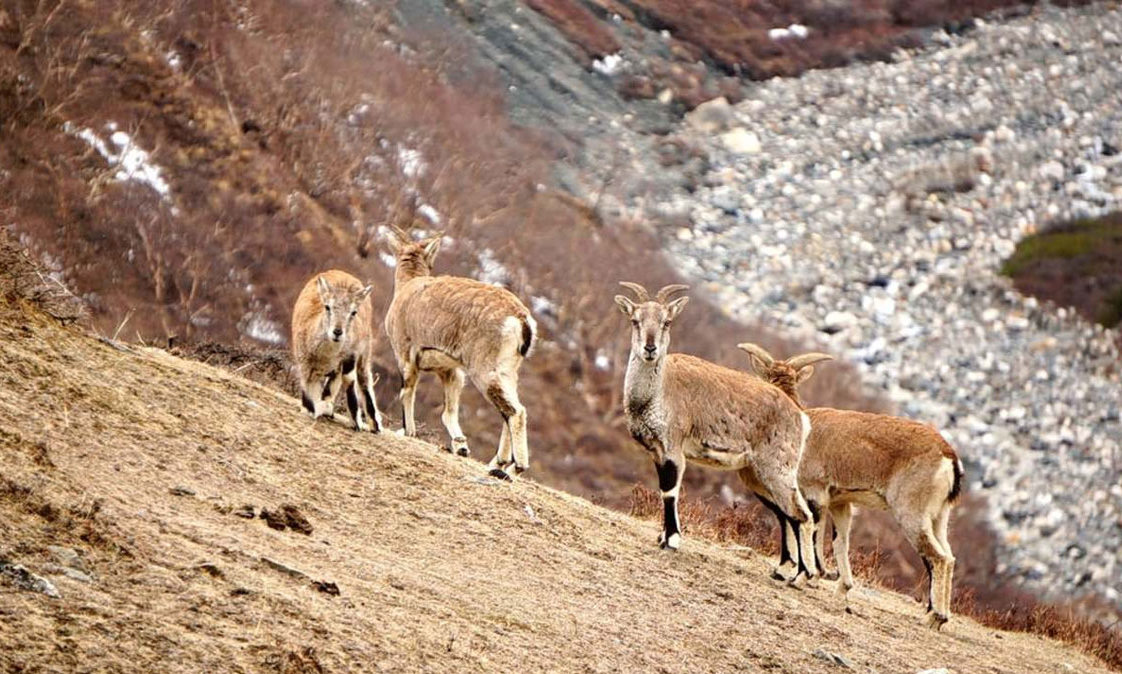
Key Features Include
- Blue Sheep & Himalayan Tahr: These species are the primary hunting targets, with strict quotas set annually to ensure their populations are not threatened.
- Revenue for Conservation: The funds generated from hunting licenses are channeled back into conservation efforts and community development.
- Scientific Monitoring: Regular assessments ensure that the hunting practices align with conservation objectives.
Explorations Include
- Trekking Trails: Traverse the scenic landscapes, offering views of majestic peaks and serene valleys.
- Cultural Interactions: Engage with local communities, understanding their deep-rooted ties with the land and wildlife.
- Biodiversity Spotting: For wildlife enthusiasts, the reserve offers opportunities to spot species like snow leopards, musk deer, and various birds.
Best Time: The hunting seasons are typically determined based on species and population studies. Generally, for Blue Sheep & Himalayan Tahr, the preferable months fall during the autumn (September to November) and spring (March to April). However, it's imperative to check with local authorities for the precise hunting windows and permits.
Dhorpatan Hunting Reserve is a testament to Nepal's innovative approach to conservation, striking a balance between tradition, community needs, and ecological sustainability. With Luxury Holidays Nepal guiding your journey, every step in Dhorpatan becomes a luxurious adventure, etching memories of a lifetime.
Nepal stands as a beacon of biodiversity conservation, with its Conservation Areas, Wildlife Reservations, and unique Hunting Zones. These regions, from the towering Himalayan peaks to the verdant Terai plains, represent Nepal's commitment to ecological balance, sustainable utilization, and cultural preservation. Whether it's the pristine trails of the Annapurna Conservation Area, the vibrant ecosystems of Shuklaphanta Wildlife Reserve, or the sustainable hunting practices in Dhorpatan Hunting Reserve, each offers a distinct testament to Nepal's multifaceted approach to preserving its natural heritage.
Engaging with these ecological wonders, tourists and conservationists alike witness a blend of nature, culture, and adventure. With each visit, they contribute to local communities, participate in sustainable practices, and immerse themselves in unparalleled biodiversity. As travel and conservation trends evolve, Nepal remains at the forefront, ensuring that its natural treasures are both celebrated and protected for generations to come.
If you need any further information, please contact us by email: [email protected], Phone: +977- 985 100 5129 (WhatsApp)